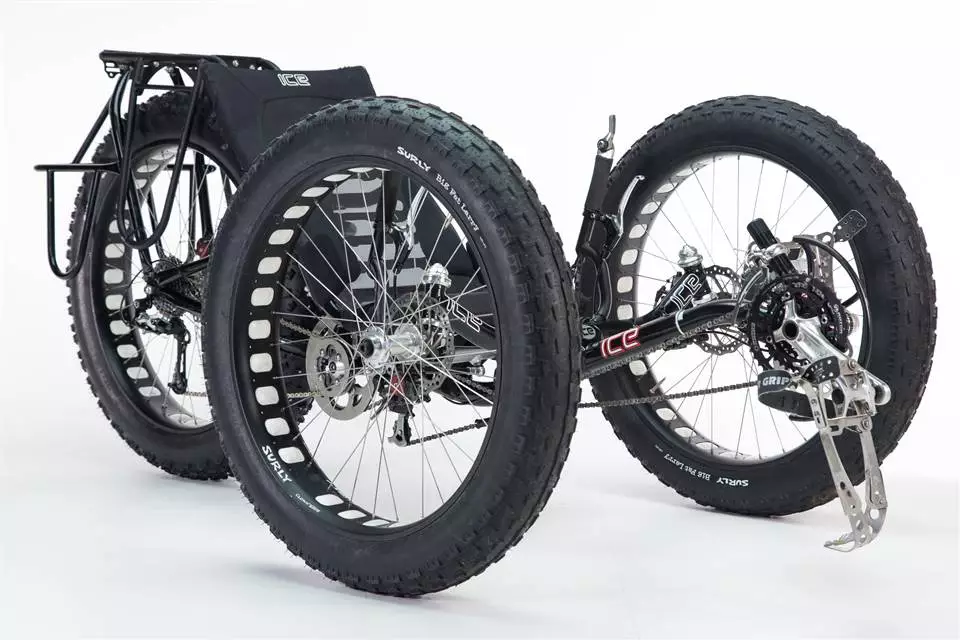Last winter, polar explorer Eric Larsen attempted to become the first person to cycle to the South Pole. Continually stymied by deep, unrideable snow, Larsen fell behind schedule and was forced to abandon the attempt. This year, several others are taking up the challenge. Thirty-five year-old British adventurer Maria Leijerstam is hoping the ticket to success is a fat-tired recumbent trike built to task.
While most of us are buying last-minute gifts and preparing to welcome loved ones into our homes, Leijerstam is pedaling herself and 99 lb (45 kg) worth of gear across the frozen continent. Unlike Larsen, who made his attempt without competition from other cyclists, Leijerstam is racing against Spaniard Juan Mendez and American Daniel Burton. They will take different routes, but they are all striving to be the first to the Pole.
Larsen used a customized Surly Moonlander fat bike during his attempt last winter, and both Mendez and Burton are using two-wheelers. Leijerstam has a different idea: a recumbent trike designed by the UK's Inspired Cycle Engineering (ICE).
"Fat bikes fail because they get blown over in the high winds, or can’t ride fast enough through the snow to stay upright," Leijerstam explains on ICE's blog. "I knew I needed something that would overcome these limitations."
Nicknamed the White ICE Cycle, Leijerstam's trike offers stability, balance and increased aerodynamics that bicycles simply can't match. Instead of expending energy trying to stay balanced, Leijerstam will be able to focus on moving forward during grueling, 18-hour days, even when it entails 50 mph (80 km/h) winds and stiff climbs up the crevasse-littered Leverett Glacier.
ICE used its Sprint trike as the basis for the extreme build, including standard components like its ergonomic mesh seat and indirect steering system. In order to prepare the vessel for the harsh challenges of extended Antarctic travel, ICE upgraded the design from a US$3,000 stock trike to a ~$33,000 extreme polar-cycle.

ICE started by reinforcing the frame, replacing aluminum elements with aircraft-grade, heat-treated 4130 chromoly steel. It added a mid-drive to step gearing down 2 to 1, providing easier pedaling for the steep uphill slogs. It also reworked the rear-end geometry to accommodate the low gearing and fat snow tires.
The trike's reinforced wheels are mounted on Hope Fatsno hubs. The front wheels are wrapped in 4.7-in Surly Big Fat Larry tires, and the rear wheel uses a 4.8-in Surly Lou with spikes added for extra traction and muscle. A custom rack system handles gear storage.
"The trike is amazing," reports Leijerstam. "It’s completely stable, even in extreme winds and I can take on long steep hills that I’d never be able to climb on a bike."
Leijerstam is wheeling over a route that ICE describes as "virtually untested by polar explorers." The trip will take her more than 400 miles (644 km) from the edge of the Ross Ice Shelf, up over Leverett Glacier, and onward to the South Pole. Along the way she'll face some of the harshest terrain and weather conditions on Earth, including temperatures as low as -31° F (-35° C), snowstorms and deep snowdrifts. She'll need to rely on every bit of her training and competition experience from places like Siberia and Iceland.
Leijerstam arrived at the Novo Russian Airbase in Antartica on December 12 and got underway on the trike journey on the 17th, making it 25 miles (45 km) up the Leverett Glacier before retiring to her tent for the night. Her plan calls for pedaling and camping for up to 20 days.
You can watch the White ICE Cycle come together in the video below. Those interested can follow Leijerstam's progress at whiteicecycle.com.
Source: Inspired Cycle Engineering via GearJunkie






